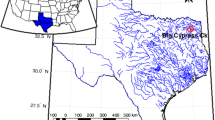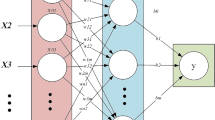Abstract
The main objective of this study is to derive a flexible approach based on machine learning techniques, i.e. Support Vector Regression (SVR), for monthly river discharge forecasting with 1-month lead time. The proposed approach has been tested over 300 alpine basins, in order to explore advantages and limits in an operational perspective. The main relevant input features in the forecast performances are the snow cover areas and the discharge behavior of the previous years. Forecasts obtained by training SVR machine on single gauging stations show better performances than the average of the previous 10 years, considered as benchmark, in 94% of the cases, with a mean improvement of about 48% in root mean square error. In case of poorly gauged basins, to increase the number of training sample, multiple basins have been considered to train the SVR machine. In this case, performances are still better than the benchmark, even if worse than those of SVR machine trained on single basins, with a decrease of the performances ranging from 13% to 54%.


Similar content being viewed by others
References
Bartolini E, Claps P, D’odorico P (2009) Interannual variability of winter precipitation in the European Alps: relations with the North Atlantic Oscillation. Hydrol Earth Syst Sci 13(1):17–25
Bauer-Gottwein PJ-S (2015) Operational river discharge forecasting in poorly gauged basins: the Kavan-go River basin case study. Hydrol Earth Syst Sci 19(3):1469–1485
Beniston M (2006) Mountain weather and climate: a general overview and a focus on climatic change in the Alps. Hydrobiologia 562(1):3–16
Berthet L, Andréassian V, Perrin C, Javelle P (2009) How crucial is it to account for the antecedent moisture conditions in flood forecasting? Comparison of event-based and continuous approaches on 178 basins. Hydrol Earth Syst Sci Discuss 13:819
Bras RL, Rodriguez-Iturbe I (1985) Random functions and hydrology. Dover Publications, New York
Callegari M, Mazzoli P, De Gregorio L, Notarnicola C, Pasolli L, Petitta M, Pistocchi A (2015) Seasonal River Discharge Forecasting Using Support Vector Regression: A Case Study in the Italian Alps. Water 7(5):2494–2515
Dumedah G, Coulibaly P (2013) Evolutionary assimilation of streamflow in distributed hydrologic modeling using in-situ soil moisture data. Adv Water Resour 53:231–241
Haylock M, Hofstra N, Tank AK, Klok E, Jones P, New M (2008) A European daily high-resolution gridded dataset of surface temperature and rainfall J Geophys Res (Atmospheres):113(D20119):1–12
Hsu KG (1995) Artificial neural network modeling of the rainfall-runoff process. Water Resour Res 31(10):2517–2530
Legates DR, Mahmood R, Levia DF, DeLiberty TL, Quiring SM, Houser C, Nelson FE (2011) Soil moisture: A central and unifying theme in physical geography. Prog Phys Geogr 35(1):65–86
Mehrkesh, A., & Ahmadi, M. (2014). Forecasting the Colorado River Discharge Using an Artificial Neural Network (ANN) Approach. arXiv preprint arXiv:1411.7508
Messerli B, Ives JD (1997) Mountains of the World: A Global Priority. Parthenon Publishing, New York. doi:10.1002/(SICI)1099-145X(200003/04)11:2<197:AID-LDR390>3.0.CO;2-U
Mohsen BK (2009) Generalization performance of support vector machines and neural networks in runoff modeling. Expert Syst Appl 36(4):7624–7629
Notarnicola C et al (2013a) Snow cover maps from MODIS images at 250 m resolution, Part 1: Algorithm description. Remote Sens 5:110–126
Notarnicola C et al (2013b) Snow Cover Maps from MODIS Images at 250 m Resolution, Part 2: Validation. Remote Sens 5:1568–1587
Pappenberger F, Ramos M, Cloke H, Wetterhall F, Alfieri L, Bogner K et al (2015) How do I know if my forecasts are better? Using benchmarks in hydrological ensemble prediction. J Hydrol 522:697–713
Rodell M, Houser P, Jambor U, Gottschalck J, Mitchell K, Meng C-J et al (2004) The Global Land Data Assimilation System. Bull Amer Meteor Soc 85(3):381–394
Salas JD (1980) Applied Modeling of Hydrologic Time Series. Water Resources Publication, Littleton, Colorado
SEPA, (2009). Change in river flow variability in snow influenced catchments in Scotland. Retrieved from http://www.sepa.org.uk/climate_change/publications.asp
Smola AJ, Schölkopf B (2004) A tutorial on support vector regression. Stat Comput 14(3):199–222
Solomatine D, See LM, Abrahart RJ (2008) Data-driven modelling: concepts, approaches and experiences. In: Abrahart RJ, See LM, Solomatine DP (eds) Practical hydroinformatics: computational intelligence and technological developments in water application. Springer, Berlin, pp 17–30
Viviroli D, Weingartner R (2004) The hydrological significance of mountains: from regional to global scale. Hydrol Earth Syst Sci Discuss 8(6):1017–1030
Vogt JV, Soille P, de Jager AL, Rimaviciute E, Mehl W (2007) A pan-European river and catchment database. EC-JRC Report EUR 22920 EN, Luxembourg, pp 120
Wang WC, Chau KW, Cheng CT, Qiu L (2009) A comparison of performance of several artificial intelligence methods for forecasting monthly discharge time series. J Hydrol 374:294–306
Wang H, Fu X (2014) Utilization of climate information and soil moisture estimates to provide monthly and sub-monthly streamflow forecasts. Int J Climatol 34:3515–3527
Wood EF, Szollosi-Nagy A (1980) Real-Time Forecasting/Control of Water Resource Systems; Selected Papers from an IIASA Workshop, October 18–21, 1976. Pergamon Press
Zealand CM (1999) Short term streamflow forecasting using artificial neural networks. J Hydrol 214:32–48
Websites:
Discharge data from websites. (2015). Retrieved from Piedmont region, Emilia-Romagna Region, France, Slovenia, Swiss: www.arpa.piemonte.it, www.arpa.emr.it, www.eaufrance.fr, www.arso.gov.si/en/water/data, www.hydrodaten.admin.ch
Retrieved from GLDAS (2015), EOBS: http://disc.sci.gsfc.nasa.gov/hydrology/data-holdings, http://www.ecad.eu/download/ensembles/download.php
Acknowledgments
The research was conducted with support awarded to GECOsistema, R&D Unit Sudtirol, by the Province of Bolzano (LP 14/2006, “Bando Innovazione” 2011), in collaboration with EURAC Research.
We acknowledge the E-OBS dataset from the EU-FP6 project ENSEMBLES (http://ensembles-eu.metoffice.com) and the data providers in the ECA&D project (http://www.ecad.eu).
The data used in this study [GLDAS] were acquired as part of the mission of NASA’s Earth Science Division and archived and distributed by the Goddard Earth Sciences (GES) Data and Information Services Center (DISC).
Author information
Authors and Affiliations
Corresponding author
Rights and permissions
About this article
Cite this article
De Gregorio, L., Callegari, M., Mazzoli, P. et al. Operational River Discharge Forecasting with Support Vector Regression Technique Applied to Alpine Catchments: Results, Advantages, Limits and Lesson Learned. Water Resour Manage 32, 229–242 (2018). https://doi.org/10.1007/s11269-017-1806-3
Received:
Accepted:
Published:
Issue Date:
DOI: https://doi.org/10.1007/s11269-017-1806-3




